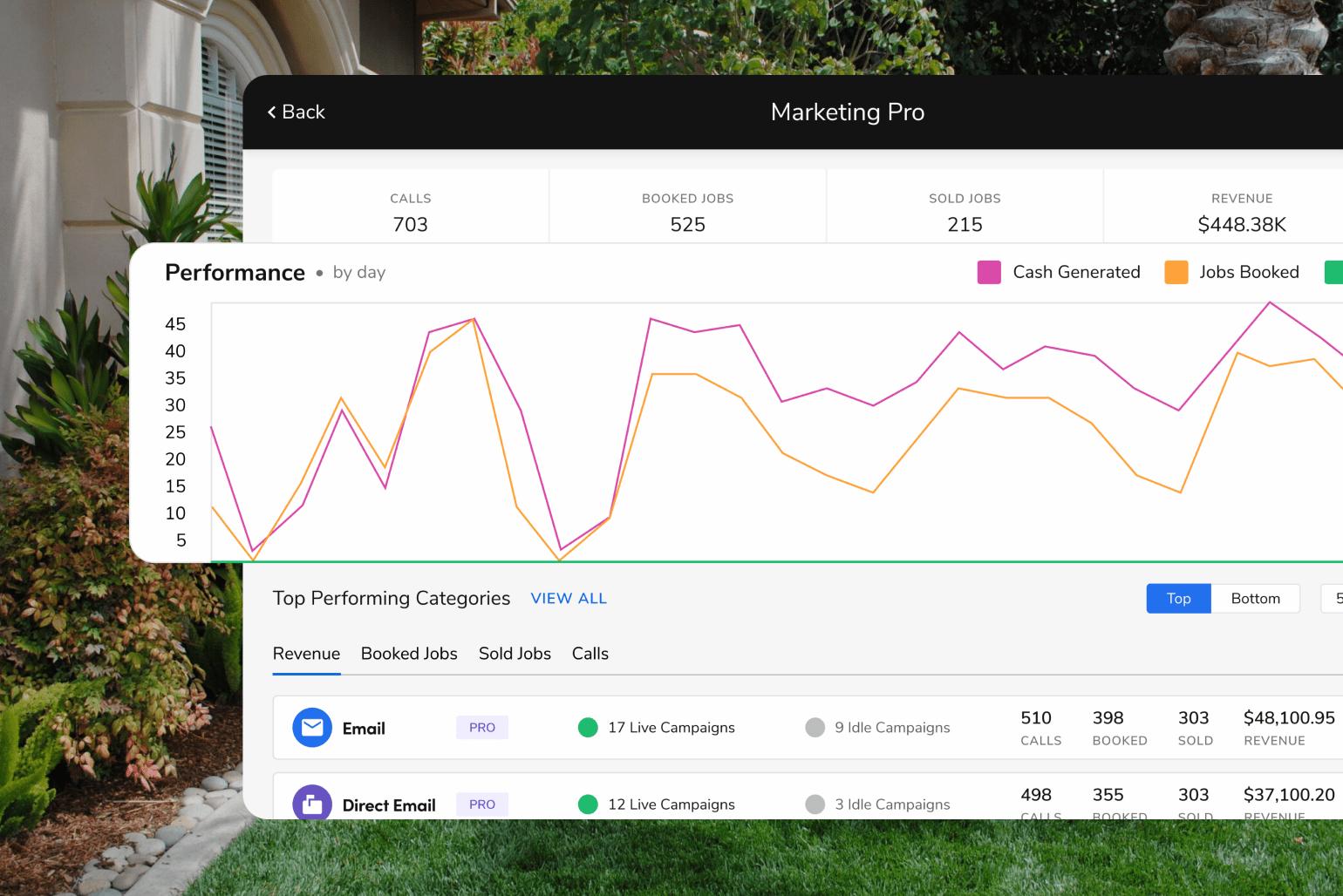How To Build An Effective Lawn Service Business Plan

No matter where you’re located, there will always be a demand for high-quality lawn service businesses. As long as individuals and organizations own or rent outdoor spaces, they will need help maintaining them. Whether your lawn care business is a team of professionals or a one-person operation, creating a business plan for lawn care startups demonstrates a clear purpose and serves as a guide for building your business.
What Is A Business Plan?
Every successful company has a business plan. Businesses don’t flourish by accident; they require strategic thought and careful planning. A business plan is a written strategy for defining, marketing, budgeting, and growing your business. It is your recipe for not surviving, but thriving in the present and future. A landscape business plan is your roadmap to success and longevity.
Why Do You Need A Business Plan For A Lawn Care Startup?
Lawn service business plans act as a reference guide as your business grows. Outlining your initial offerings, scope, target customer, marketing strategy, and other important components can be extremely helpful when you are six months into a new business and may feel like you have lost your footing. It can also be shared with key employees you hire down the line to help them understand how the business operates.
Business plans are also crucial if you plan to expand your startup and need to secure money from grants or loans. A good lawn care business plan can attract investors and business partners to support your vision. It proves you know how to make a profit and assures investors that they will get a return on their investment.
How To Make A Lawn Care Service Business Plan
Here is a step-by-step guide on creating successful lawn mowing business plans to ensure your success down the line.
First, decide if your business would benefit more from a traditional business plan or a lean startup plan.
A traditional plan is detailed, thorough, and commonly used. This is what most investors, business partners, and funding sources expect. This format is often the most comprehensive because it forces you to think deeply about your endeavor and anticipate problems before they arise.
A lean startup plan is a more brief version of the same structure. In other words, it is a one-page summary. This might be all you need, especially if you suspect you may change direction. We cover the lean startup outline below.
Determine the audience of your lawn care business plan. If it is only for your reference, it won’t require a highly polished, perfectly formatted aesthetic.
If you plan to use it to apply for funding, take the time to create a cover page. The cover page should include your name and contact information, your business’ name and logo if you have one (otherwise a graphic or an image), and the date. If formatting documents is not your strong suit, see if one of your team members can assist, or consider reaching out to a graphic designer.
Executive Summary: In a few paragraphs, address the following. Do not go into detail here yet — there will be sections below for further explanation. Touch on the following aspects of your business:
Location: Will you serve a neighborhood, a zip code, or several counties?
Business size: Is this a one-person show, a small team, a family business, or something you plan to grow into your region’s leading enterprise? Note the business structure, such as LLC.
Mission statement: Craft a mission statement that encapsulates your values and addresses any special focus you bring, such as top-notch customer satisfaction or attention to reducing water waste.
Your services: Note if you offer mowing, curb appeal, tree cutting, etc.
Your target customer: Busy working families? Business parks? Entertainment venues? Different demographics and properties offer different types of green spaces that your business can specialize in.
Why you will be successful in your objectives: For example, this could be an unmatched commitment to professionalism that will earn you a certain number of reviews in a certain period of time. Or your previous marketing experience that will help grow your business within six months.
Business Description: Go into more detail here about aspects of your executive summary. Name your team members or the roles you intend to fill in the future. Elaborate on the values suggested in your mission statement.
Offerings: List the services you will offer along with their rates. Make sure the rates are appropriate for your target customer and location. Only list services that you will realistically be able to offer at the beginning, according to your size and experience level. Note how often you will be able to serve your customers.
If you plan to expand your offerings when you scale your business, that can be noted in this section or the Revenue Projection section described below.
Business Structure: Define your role and the roles of other team members you plan to bring on board. Briefly state the background and qualifications of the core team members, even if it’s just you. Adding a chart, visual, or table may help explain the flow of responsibility within your organization.
State if the business is a sole proprietorship, LLC, a B-corp, or a different kind of entity. (The U.S. Small Business Administration explains each business structure.)
Competitor Analysis: What services are similar lawn care businesses offering? Analyze the strengths and weaknesses of similar businesses in the area and how you can learn from them. How can your business perform those services better or differently that warrants the need in your community for your business to exist? Address market saturation and the gap in the market that will allow your business to shine.
Additionally, address trends in lawn care that you can take advantage of. If research suggests an increased interest in lawn maintenance in your region, this section is the place to mention it. For example, perhaps you have witnessed that more people are manicuring their lawns recently due to increased working-from-home lifestyles and attention on home and property during the COVID-19 pandemic.
Marketing Strategy: You can have excellent service and the happiest customers in the world, but if people don’t know about your business, it can’t grow, and chances are your business won’t survive the long haul. Create an optimized website so that Google’s algorithm understands what services your lawn care business offers and where you’re located. Consider free online marketing tools, social media, word of mouth, flyers posted around town or in mailboxes, and television or newspaper ads. Use what makes sense for your budget and the mediums geared towards your target audience.
Revenue Projection: This is where you’ll outline how much you expect the lawn service business to earn within a certain number of years. Be sure to factor in inflation and the cost of labor, equipment, and transportation. Outline how you plan to grow your business by offering new services, applying for grants down the line, and/or expanding your reach.
If you already have bank statements showing your revenue thus far, showcase that progress.
The Ask: If you’re submitting your landscaping business plan to seek funding, investment, or business partnership, use this section to make that pitch. The previous revenue projection section will show that your business is worthy of investment. State how much money is required to meet your goals or how the proposed business partnership will be mutually beneficial.
Supporting documentation: Add anything else that showcases your credibility as a business person or an expert in the lawn care industry. If you are a first-time business owner, this optional section can showcase your commitment to excellence.
For a simplified lean startup plan, you need only write a sentence or two to concisely address the following:
Business name and objective: State your name and specify which lawn services you offer.
Your solutions: State how your business meets the needs of your target customer and stands out from the competition. Your competitors may be offering different services in a different way, or on a different schedule, or at a different price — mention that in this section. If in writing this, you realize your business model is too similar to an existing business, rethink your strategy for how to stand out.
For example, if you are a general lawn service business, perhaps highlight your efficiency and convenience for surrounding neighborhoods.
Alternatively, if you are a niche landscaping company specializing in ornate bush trimming, state that you will market to high-income demographics or corporate entities.
Your partnerships: Name the contractors, suppliers, distributors, and any other business you will work with.
Your marketing strategy: Briefly state how you will communicate your business to your target customer — physically and online (flyers, referrals, email campaigns, etc.).
Your team: State the number of initial employees — even if it is just yourself. Note the business structure (sole proprietorship, LLC, or other).
Your revenue streams: For example, besides offering lawn services, are you also offering consulting, selling grass seed, or seeing revenue from an optimized lawn care blog?
Startup expenses: List any purchased or rented equipment and costs for transportation and labor.
Goals for the future: Note goals such as a profit amount you plan to make by your first year in business and if you plan to double in size within five years.
Tips for Creating a Lawn Maintenance Business Plan
Now that you have an overall roadmap for your business plan, here are some additional tips for curating it and making it the best it can be.
While it makes sense to have a cover page, a business summary, and a business description upfront, the order of the following sections in your lawn service business plan can vary. Tailor it to your business.m
Start with your strengths. If your lawn care business has a unique hook — like if all team members are sisters, or you use all organic products — don’t wait to reveal that until the end (especially if you’re up against steep competition for funding, the reader might not get to the end!). Capture the reader’s attention on the first page with the strongest aspects of your business. Sell your idea, then follow through with how you will accomplish it successfully.
The more detailed, the better. A half-baked idea won’t succeed. The more thought-out your lawn service business plan is, the more impressive you will come across to potential partners and investors.
Although photos are not required, the old adage rings true: a picture tells a thousand words. If you have photos, like the before and after of a lawn, or testimonials of customers who have benefitted from your services in the past, that could be great for additional documentation. It proves your worth and demonstrates customer satisfaction.
If you need more visual inspiration, check out these examples for lawn care business plan templates.
FieldRoutes Helps You Grow
The importance of a business plan can’t be understated. However, what you do after making your plan is just as crucial. The average revenue growth rate from 2020-2021 for the PCT Top 100 customers using the FieldRoutes Operations Suite was 30%. Try our free demo to see for yourself how we can help fulfill the goals of your lawn mowing business plan. Our software works together with you to streamline, grow, and scale your business. Contact FieldRoutes today to learn more.





